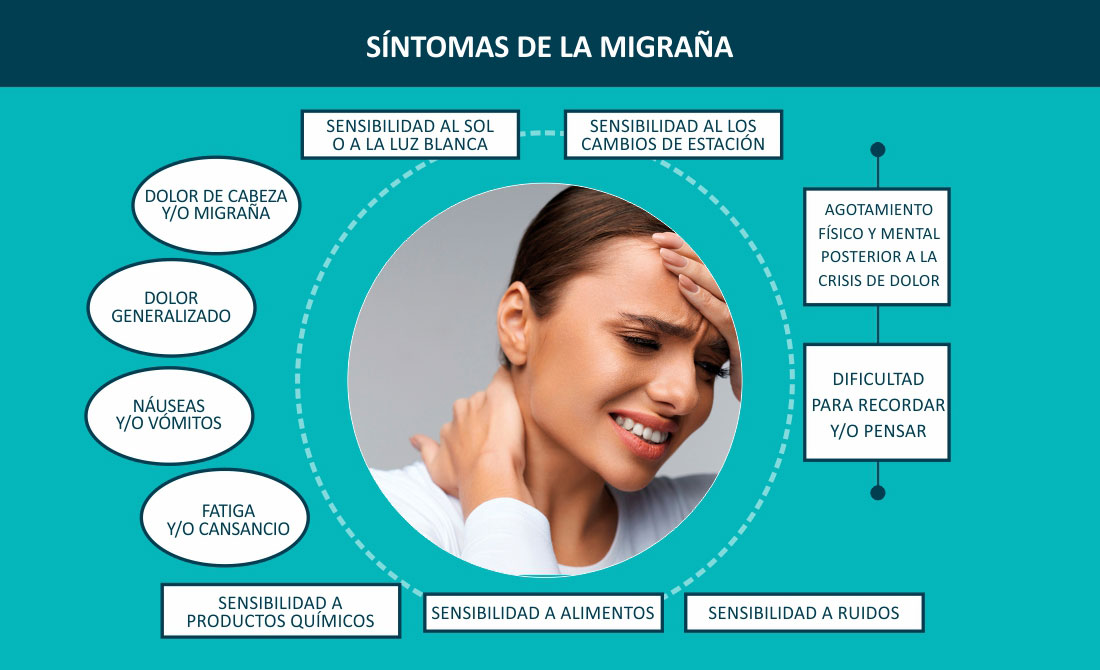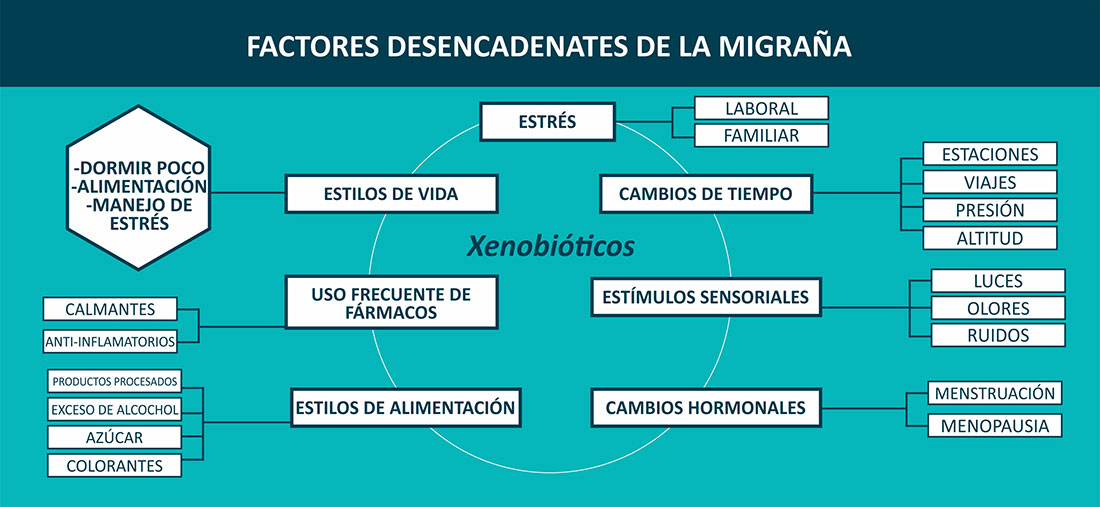MIGRAÑA
Migraña y/o cefalea tensional
La migraña es un tipo de dolor de cabeza, que está acompañado de nauseas, vómitos, sensibilidad a la luz, olores y ruidos. Una de las características más comunes es la presencia de dolor pulsátil en un lado de la cabeza y su intensidad puede aumentar, entre otros factores, por la luz, los movimientos de cabeza, situaciones de estrés o mala alimentación (rica en productos procesados). Así mismo un gran número de pacientes con migraña presentan hipersensibilización del sistema nervioso central, sensibilización a alimentos y/o fármacos, disfunción inmunoneuroendocrina, alteraciones comunes con el Síndrome de Sensibilidad Central.
“La migraña en su conjunto está encuadrada dentro de las 20 enfermedades más discapacitantes de todas las existentes"



ARTÍCULOS CIENTÍFICOS
Miller, J. A., Missmer, S. A., Vitonis, A. F., Sarda, V., Laufer, M. R., DiVasta, A. D. (2018). Prevalence of migraines in adolescents with endometriosis. Fertility and sterility, 109(4), 685-690.
Yunker, A. (2018). Co-occurrence of chronic pain disorders in adolescents suggests early pain programming and possible timing for intervention.
Seidel, S., Hartl, T., Weber, M., Matterey, S., Paul, A., Riederer, F., PAMINA Study Group. (2009). Quality of sleep, fatigue and daytime sleepiness in migraine—a controlled study. Cephalalgia, 29(6), 662-669.
Gürsoy, S., Erdal, E., Herken, H., Madenci, E., Alaşehirli, B., Erdal, N. (2003). Significance of catechol-O-methyltransferase gene polymorphism in fibromyalgia syndrome. Rheumatology international, 23(3), 104-107.
Gürsoy, S., Erdal, E., Herken, H., Madenci, E., Alaşehirli, B., Erdal, N. (2003). Significance of catechol-O-methyltransferase gene polymorphism in fibromyalgia syndrome. Rheumatology international, 23(3), 104-107.
Mauskop, A., & Altura, B. M. (1998). Role of magnesium in the pathogenesis and treatment of migraines. Clinical Neuroscience, 5(1), 24-27.
Burstein, R., Noseda, R., & Borsook, D. (2015). Migraine: multiple processes, complex pathophysiology. Journal of Neuroscience, 35(17), 6619-6629.
Gómez-Argüelles, J. M., & Anciones, B. (2009). Prevalencia de síntomas neurológicos asociados a la fibromialgia. Revista de la Sociedad Española del Dolor, 16(4), 222-229.
Seo, J. G., & Park, S. P. (2018). Significance of fatigue in patients with migraine. Journal of Clinical Neuroscience, 50, 69-73.
Heijtz, R. D., Wang, S., Anuar, F., Qian, Y., Björkholm, B., Samuelsson, A., Pettersson, S. (2011). Normal gut microbiota modulates brain development and behavior. Proceedings of the National Academy of Sciences, 108(7), 3047-3052.
Ferrari, M. D., Klever, R. R., Terwindt, G. M., Ayata, C., Van den Maagdenberg, A. M. (2015). Migraine pathophysiology: lessons from mouse models and human genetics. The Lancet Neurology, 14(1), 65-80.
Dimitrova, A. K., Ungaro, R. C., Lebwohl, B., Lewis, S. K., Tennyson, C. A., Green, M. W., Green, P. H. (2013). Prevalence of migraine in patients with celiac disease and inflammatory bowel disease. Headache: The Journal of Head and Face Pain, 53(2), 344-355.
Brummett, C., & Clauw, D. J. (2018). Fibromyalgia and Centralized Pain States. In Essentials of Pain Medicine (Fourth Edition) (pp. 213-222).
Cady, R. K., Farmer, K., Dexter, J. K., Hall, J. (2012). The bowel and migraine: update on celiac disease and irritable bowel syndrome. Current pain and headache reports, 16(3), 278-286.
Alehan, F., Ozçay, F., Eroi, I., Canan, O., & Cemil, T. (2008). Increased risk for coeliac disease in paediatric patients with migraine. Cephalalgia, 28(9), 945-949.
Goadsby, P. J., Holland, P. R., Martins-Oliveira, M., Hoffmann, J., Schankin, C., Akerman, S. (2017). Pathophysiology of migraine: a disorder of sensory processing. Physiological reviews, 97(2), 553-622.
Chai, N. C., Rosenberg, J. D., & Peterlin, B. L. (2012). The epidemiology and comorbidities of migraine and tension-type headache. Techniques in regional anesthesia and pain management, 16(1), 4-13.
Ferracini, G. N., Chaves, T. C., Dach, F., Bevilaqua-Grossi, D., Fernández-de-las-Peñas, C., Speciali, J. G. (2017). Analysis of the cranio-cervical curvatures in subjects with migraine with and without neck pain. Physiotherapy, 103(4), 392-399.
Chapman, C. R., Tuckett, R. P., & Song, C. W. (2008). Pain and stress in a systems perspective: reciprocal neural, endocrine, and immune interactions. The Journal of Pain, 9(2), 122-145.
Rosa, A. C., & Fantozzi, R. (2013). The role of histamine in neurogenic inflammation. British journal of pharmacology, 170(1), 38-45.
Ciregia, F., Giacomelli, C., Giusti, L., Boldrini, C., Piga, I., Pepe, P., Bazzichi, L. (2018). Putative salivary biomarkers useful to differentiate patients with fibromyalgia. Journal of proteomics.
Yildirim, T., & Alp, R. (2017). The role of oxidative stress in the relation between fibromyalgia and obstructive sleep apnea syndrome. Eur Rev Med Pharmacol Sci, 21(1), 20-29.









